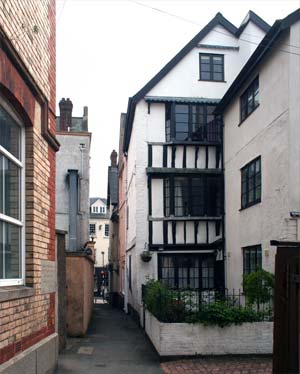
Mint Lane and the Mint
Page updated 13 May 2009
 The lane and place may have
been named after a mint
that was set up by Royalists during the Civil War in Friernhay Street.
However, it is known that another
mint was set up in Mary Arches Street in 1696, and it may be after this
mint that it was named. The lane was already in existence, running
through part of the cloisters of St
Nicholas Priory, after Henry VIII had suppressed it. The map shows the
street circa 1905.
The Mint Tavern, on the corner of Mint Lane and Fore Street was
originally a private house before becoming "The Medicine and Chemical
Hall" apothecary in 1838. It was also known as the Star and Star
Stores before becoming the Mint Tavern. No 21, the Mint was originally
the north range of the Priory and
was the monks refectory. It has recently been refurbished and is open
to the public for one Sunday every month.
The lane and place may have
been named after a mint
that was set up by Royalists during the Civil War in Friernhay Street.
However, it is known that another
mint was set up in Mary Arches Street in 1696, and it may be after this
mint that it was named. The lane was already in existence, running
through part of the cloisters of St
Nicholas Priory, after Henry VIII had suppressed it. The map shows the
street circa 1905.
The Mint Tavern, on the corner of Mint Lane and Fore Street was
originally a private house before becoming "The Medicine and Chemical
Hall" apothecary in 1838. It was also known as the Star and Star
Stores before becoming the Mint Tavern. No 21, the Mint was originally
the north range of the Priory and
was the monks refectory. It has recently been refurbished and is open
to the public for one Sunday every month.
In the first two decades of the 19th-Century, Mr David, and his widow from 1814, carried on the trade of stay and corset maker's from Mint Lane. Otherwise, the main industry of the lane appears to have been the Wesleyan Mint Chapel, with many adverts for services and the frequent appearance of guest preachers. It is almost a relief to find that, in 1879, Fanny Eliza Smale was convicted for drunkenness in Mint Lane, fined 5s and costs or seven days in prison.
John Gendall illustrated the arch, that led into St Nicholas Priory, for Thomas Shapter's report on the Exeter cholera outbreak of 1832. In it, he showed the pump, which had been installed by a local named Lawler shortly before the outbreak - the many wells of Exeter were blamed for the spread of the cholera, although subsequent research has found that they were not to blame. One of the small gardens on Mint Lane has a well, which can be seen by peering over the wall. It was also a source of pure water for the inhabitants of Mint Lane.. Some occupants of buildings in Mint Lane in 1897.
(The), 155
Fore street to Bartholomew st. west.
2 Gramble William Haywood, boot maker
6 Rice James, last & boot tree maker
7 Seward John, corn dealer
8 Bendall Joseph, tailor
9 Hern William, joiner
10 Hammett Mrs.Mary Brice, bill poster
11 St. Wilfred's Creche, Sister Agatha in charge
12 St. Wilfred's Recreation Rooms (Henry Tapscott, caretaker)
17 Bidgood Thomas
18 Martin Miss L. E. dress ma
THE PRIORY :
Huxtable Miss
Tucker Miss
Featherstonehaugh Rev.Thos. [Wesleyan]
Catholic School
Wesleyan School
Memorial hall (Jas. Odam, caretaker)
29 Hill Henry, brass founder
Trimble Jn. Thos.pawnbrkr

 The small garden on the right has a well that provided pure water to Mint Lane.
The small garden on the right has a well that provided pure water to Mint Lane.
│ Top of Page │